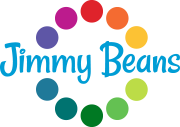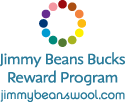.jpg) Not to make anyone feel rushed but it's time to choose the second square for The Great American Aran Afghan KAL (TGAAA KAL)! I haven't made a lot of progress on my first square this week either so don't feel behind! Remember this is a low stress, work at your own pace project. There will most likely be months when you can whip out two or more squares!
Not to make anyone feel rushed but it's time to choose the second square for The Great American Aran Afghan KAL (TGAAA KAL)! I haven't made a lot of progress on my first square this week either so don't feel behind! Remember this is a low stress, work at your own pace project. There will most likely be months when you can whip out two or more squares!Please do send me photos of your finished squares and I'll post them up here on the blog with your permission!!! Here is a finished and blocked square from on of our Ravelry members, Tanya.
While the first square I chose for us to work on is not listed as one of the five easiest, I felt it was a good one to start with because of the garter stitch back ground, simple opposing cables and simple lace eyelet heart pattern center for interest. For those of you just joining us, the square is the one on page 22 designed by Carol Adams. I hope my choice has been a good one for most of you and that you're not experiencing too much frustration. If so, please let me know and I'll do my best to help you through the difficult part.
Another reason I chose this square is that it does plunge you into learning the two types of charts utilized in Aran patterns. The first chart everyone should learn, whether you are working from the written instructions or the pattern charts is the Pattern Arrangement chart. This little chart tells you in which order to work the pattern instructions or charts. Since we are working flat and not in the round, the pattern arrangement chart is worked from right to left on odd rows and left to right for even rows. It's a good habit to always read charts this way because not all charts are symmetrical and it's way too easy to make assumptions, then knit away only to later realize that half the pattern is backwards.Yes, some patterns are symmetrical but don't assume they are. You know what "they" say about assumptions!
The second type of chart for each of these squares is a very typical chart. Again, these charts are read beginning at the bottom right hand corner, working each odd row right to left and each even row left to right. Unless the pattern specifically says otherwise.
So for this first square the pattern arrangement chart says to work three garter stitch edge stitches, row 1 of chart A, row 1 of chart B, row 1 of chart A, row 1 of chart C, row 1 of chart A, row 1 of chart D, and finally one last repeat of row 1 of chart A and the last three garter stitch edge stitches.
You'll notice that each of the four pattern charts have a different numbers of rows. This is where Aran knitting becomes a bit interesting. Keeping a tally or using one of the stitch counting apps that allows multi-counts are very handy. You'll see that chart C has 24 rows, so you will go back to row 1 of chart A on every odd row of Chart C. For charts B & D you start with row 1 and continue through the first eight rows matching row for row with chart C. Then, when you begin your second and subsequent repeats of charts B & D you will treat row 3 as if it were row 1. Following the instructions in the Square paragraph you'll keep working these charts in order and ending after working row 1 of charts A & C and row 7 of charts B & D. In other words, you will not be completing all charts.
One final note before moving on. When the instructions say to CO and work three ridges this means to cast on and knit six rows. Since we're working in garter stitch, in order to get three ridges on each side of the work you must work six rows. Two rows in garter stitch = one garter stitch ridge. If you didn't knit six rows, don't sweat it and please don't go ripping back to start over. Just keep going and then do all of you're squares the same way through out, so that they are consistent. Or alternatively, we could look at adding a little bit of single crochet to this one square to make it work.
I hope this clears up some of the confusions I've been seeing. If I can give further explanations please let me know.
.jpg) Now, for square two! We will officially start the second square on Monday Sept. 9th. For this one we will be working the square on page 16, designed by Barbara Selesnick. This one will give us more practice working some simple twist type cables as well as introducing us to traveling stitches. What are traveling stitches you ask? Basically, traveling stitches are stitches that "move" across the work instead of staying in columns. This square starts with a simple four stitch cable for the base of each heart then the two sets of stitches will gradually move outward, away from each other, finally diverging into single stitches to form the lobes at the top.
Now, for square two! We will officially start the second square on Monday Sept. 9th. For this one we will be working the square on page 16, designed by Barbara Selesnick. This one will give us more practice working some simple twist type cables as well as introducing us to traveling stitches. What are traveling stitches you ask? Basically, traveling stitches are stitches that "move" across the work instead of staying in columns. This square starts with a simple four stitch cable for the base of each heart then the two sets of stitches will gradually move outward, away from each other, finally diverging into single stitches to form the lobes at the top.1 hank/skein of your chosen yarn
US #8 needle (straight or circular)
cable needle
stitch markers
The two in-store classes for working on this KAL are scheduled for Monday Sept 9th and Monday Sept 23rd at 1:30 to 3:30 pm both days. The fee for these classes is $20. Please sign up in advance if possible. Our regular JBW Knit Night will be as usual the 4th Thursday of the month, Sept. 26th at 6 to 8 pm. Everyone is welcome and this is a great time to sit, chat and work on your squares!
If you're participating in this KAL but haven't yet joined the thread in the Jimmy Beans Wool Group on Ravelry please do! There is a lot of helpful information from others who are working on this project as well as the possibility of chatting and getting to make new knitting friends! If anyone is interested in a live chat time on the Ravelry board let me know and we'll set one up!
For other classes please check out and bookmark our classes page! And a heads up! Beginning October 1st we will return to scheduling a full quarter's classes at a time so you'll have plenty of time to plan and sign up. If you aren't local but are planning a visit to Reno you are most welcome to join us for a class during your visit! If you have particular class requests please let me know at my email below.
I hadn't intended for this part of today's post to get so long! I was hoping to feature a protein fiber too but I will leave that for next weeks post. Any particular fiber you want to hear about first?
As always, if you have any question, want to sign up for or schedule a class, or need help please let me know at askTerry (at) jimmybeanswool (dot) com.
Happy cabling!!!
Terry




.jpg)











My book came yesterday, but I won't be able to begin for a bit... work gets in the way of my knitting! and I have to finish a couple of things first!
ReplyDeleteNo problem! Start when you can, this supposed to be an easy, at your own pace, learning experience.
ReplyDeleteTerry
I have finished the two blocs and posted pictures of them on your Ravelry group... Which one will be the third bloc ?
ReplyDeleteThese Helpful Hints & Square Two and September Classes, which are so creative and authentic for all, but there are also very beneficial and realistic high da guest posting website list available to getting from them in all over USA easily.
ReplyDeleteLime Kiln Dust Orlando is a byproduct of the lime manufacturing process, known for its high calcium content and alkaline properties. It is commonly used as a soil amendment to improve soil structure and pH levels, promoting healthier plant growth. Its fine texture and easy application make it a popular choice for agricultural and landscaping projects in the Orlando area.
ReplyDeleteCMOLDS stands out as a premier app development company in Dubai, combining innovation and expertise to craft cutting-edge digital solutions. With a commitment to excellence, CMOLDS transforms ideas into impactful mobile applications, contributing to the dynamic tech landscape of Dubai. Elevate your digital presence with CMOLDS' top-tier app development services.
ReplyDeleteYou should try transferring your website into a progressive web app because it looks better that way i know one PWA development company
ReplyDelete